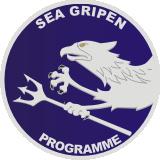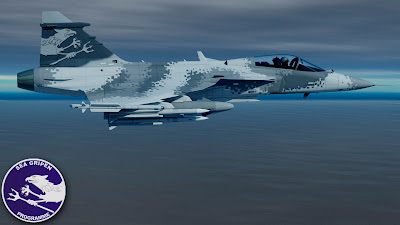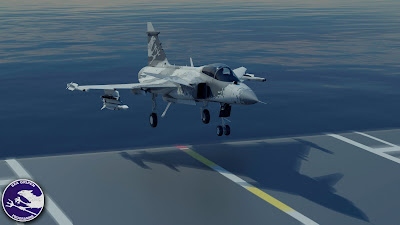Saab offers naval Gripen to India
Monday, December 28, 2009
By Saurabh Joshi
Saab AB, the Swedish defense major, has received a Request For Information (RFI) from the Indian Navy for the supply of carrier-borne fighter aircraft. The company, which received the RFI earlier this month, is pitching a little-known naval variant of its Gripen NG fighter, called the Sea Gripen. Saab is already bidding for the 126 Medium Multi Role Combat Aircraft (MMRCA) tender of the Indian Air Force (IAF), for which it has offered an advanced version of the Gripen NG, called the Gripen IN.

Saab has been studying the idea of designing a carrier-borne variant since the mid-’90s but the company only decided to launch the Sea Gripen program in the wake of its existing campaigns for the air forces of India and Brazil and the moves by the two countries to build a serious carrier capability, even though at that time there was no formal request from either country. Saab is planning to pitch the aircraft to countries with smaller-sized carriers and says they expect more nations to show interest in the Sea Gripen, because existing naval fighters are either of an older generation or large-sized, forcing them to buy or build large ships as well.
According to Peter Nilsson,
Gripen’s Vice President of Operational Capabilities, the Sea Gripen is intended for both CATOBAR (Catapult Assisted Take Off But Arrested Recovery) as well as STOBAR (Short Take Off But Arrested Recovery) operations. “There will obviously be differences in the MTOW (Maximum Take-Off Weight). In a CATOBAR concept, the Sea Gripen will have a MTOW of 16,500 kilograms and a maximum landing weight of 11,500 kilograms. In a STOBAR concept it depends on the physics of the carrier. Roughly, the payload of fuel and weapons in STOBAR operations will be one-third less than the payload in CATOBAR operations. There will be no differences in ‘bring-back’ capability,” he says.
Nilsson says Saab hasn’t had to make any dramatic changes in the basic Gripen NG to design the Sea Gripen, because of its existing abilities, saying, “What helps is the Gripen´s ability to operate from road base strips.”
“The basic Swedish Air Force requirements in the original design for enabling short strips’ operations are very like enabling carrier-based operations. Qualities like low landing speed, high pitch & roll authority, high-precision glide slope control, high-precision landing capability, high sink rate clearance, strengthened airframe etc., are built-in from the beginning. This is in addition to the Gripen´s aptitude for active service in the field with easy maintenance, like engine changes in less than an hour in the field and no need for external power etc, enabling a shorter ‘mind jump’ required for the Sea Gripen in comparison to the ability of other land-based fighters to transform into ‘deck-based’ fighters,” he says.
“We do not have to start from scratch. We do not have to redesign the aerodynamics – we do not have to redesign the flight control system or the avionics. We already have a rugged, rough and strong airframe built for ‘carrier-like’ landings,” explains Nilsson.
While all the sensors, avionics and weapons and the GE 414 of the Gripen NG will be offered in the naval variant, the Sea Gripen will be notably different with a new undercarriage and nose gear to cope with the higher sink rate forces and catapult launches, as well as an arrestor hook, which has been redesigned and ‘beefed-up’ from the existing arrestor hook in the Gripen NG.
“There is strengthening of the airframe in a few minor areas due to an even higher sink-rate clearance of over 20 feet per second and the forces and stress in catapult launches, and ‘marinizing’ of the aircraft,” says Nilsson, while stressing that the inherent Gripen NG design minimizes the need for strengthening the airframe and making the aircraft sea-worthy, as the Gripen NG already has salt-water protection and the ability to operate in hot and humid conditions.
The Sea Gripen will be around 400 kilograms heavier than the Gripen NG, with the augmented airframe giving ‘an empty weight between 7500-8000 kg’. “The Sea Gripen will be a very, very interesting alternative for nations with smaller-size carriers. Its well-balanced weight and size in comparison to heavy, twin-engine alternatives allows nations to move from ‘air defence’ carriers to a concept with strategic capabilities, without having to replace their existing carriers,” says Nilsson, also adding, “Due to its balanced size there is no need for structural changes like folding wings etc.”
While the Swedish Armed Forces are not currently looking for a carrier ability, with the Sea Gripen, Saab is looking for partnerships with nations looking for self-reliance in their naval aviation programs. “Saab AB will establish the Sea Gripen as a new-generation carrier-based fighter option in the future, offering its design and engineering skills for partnership with a country with a developed aircraft industry and a carrier-equipped navy,” says Nilsson, also adding that the Sea Gripen program’s human resource skill-sets include engineering and flying experience of carrier-based operations in both, combat as well as peace-time roles.
And while he recognizes that presence of established naval fighters, he is confident of the Gripen’s abilities. “The Sea Gripen will challenge existing carrier-based fighter manufacturers,” he says, emphasizing, “I challenge any existing deck-based fighter to perform a night landing in severe conditions with snow or rain and strong crosswinds on a Swedish standard road-base strip of 17 x 800 meters, rearming and refueling in less than 10 minutes and then taking-off. And not just once for the purpose of showing-off. The system’s performance & physics, maintenance concepts and stress tolerances should be designed for 30 years of daily operations in these conditions,” while at the same time, attesting the Gripen’s requirement for the dimensions of a landing strip to be 9 x 600 meters.
Saab offers naval Gripen to India | StratPost





